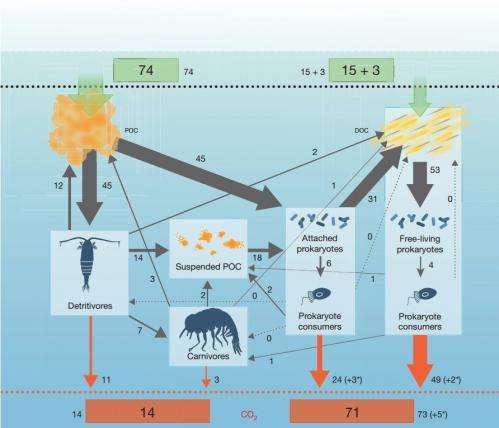March 20, 2014 report
Researchers measure carbon movement in ocean's 'twilight zone'

(Phys.org) —A team of researchers with members from France, the U.S. and the U.K. has presented its findings in measuring the movement of carbon and carbon dioxide in and out of a portion of the ocean known as the "twilight zone." In their paper published in the journal Nature, the researchers describe how they took measurements, and what they found as a result.
Scientists are interested in the "biological carbon pump"—the process by which some of the carbon dioxide in the atmosphere makes its way to ocean floors, where it is held in place, seemingly, indefinitely—because it will help to build a worldwide carbon distribution model. To understand the carbon pump, scientists need to understand what happens at ocean depths where sunlight grows dimmer and dimmer—the twilight zone.
The paper by the team is the culmination of a lot of work begun in 2009 by scientists with Britain's National Oceanography Centre —it's all based on measurements taken off the south-west coast of Ireland in a gyre called the Porcupine Abyssal Plain. The aim was to measure both carbon (organic and inorganic) and the impact on it by organisms that live in the twilight zone. They sent down a host of different instruments to various depths hoping to create what they called a comprehensive carbon budget.
The team reports that due to their efforts they have managed to balance the carbon budget and in so doing have uncovered a previously unknown carbon processing system.
Scientists have known for some time that phytoplankton living on the surface of the oceans absorb carbon dioxide—when they die, the carbon in their bodies sinks below the surface adding to "marine snow"—all manner of falling particles that also includes flesh, sand and soot. At depths ranging from 100 to 1000 meters, the falling snow passes into the twilight zone where some of the carbon in the snow is converted back into carbon dioxide and some is not and eventually falls (and is stored) on the ocean floor. What was not known was the process that is involved. In analyzing water samples, the researchers discovered that the main organisms responsible for extracting carbon out of dead matter and converting it to carbon dioxide—bacteria—aren't capable of catching marine snow on their own. Instead, they found that zooplankton capture and eat the snow, and then defecate, releasing material that drifts down much more slowly—slow enough for the bacteria to latch onto. And that's how so much carbon is captured and converted back into carbon dioxide—material that is missed (just 1 percent) winds up on the ocean floor.
More information: Reconciliation of the carbon budget in the ocean's twilight zone, Nature (2014) DOI: 10.1038/nature13123
Abstract
Photosynthesis in the surface ocean produces approximately 100 gigatonnes of organic carbon per year, of which 5 to 15 per cent is exported to the deep ocean. The rate at which the sinking carbon is converted into carbon dioxide by heterotrophic organisms at depth is important in controlling oceanic carbon storage3. It remains uncertain, however, to what extent surface ocean carbon supply meets the demand of water-column biota; the discrepancy between known carbon sources and sinks is as much as two orders of magnitude. Here we present field measurements, respiration rate estimates and a steady-state model that allow us to balance carbon sources and sinks to within observational uncertainties at the Porcupine Abyssal Plain site in the eastern North Atlantic Ocean. We find that prokaryotes are responsible for 70 to 92 per cent of the estimated remineralization in the twilight zone (depths of 50 to 1,000 metres) despite the fact that much of the organic carbon is exported in the form of large, fast-sinking particles accessible to larger zooplankton. We suggest that this occurs because zooplankton fragment and ingest half of the fast-sinking particles, of which more than 30 per cent may be released as suspended and slowly sinking matter, stimulating the deep-ocean microbial loop. The synergy between microbes and zooplankton in the twilight zone is important to our understanding of the processes controlling the oceanic carbon sink.
Journal information: Nature
© 2014 Phys.org

















